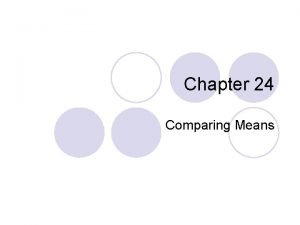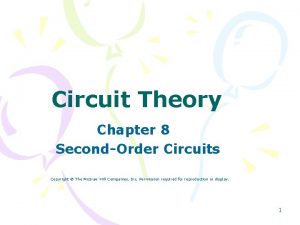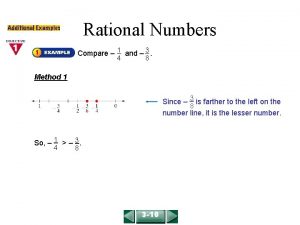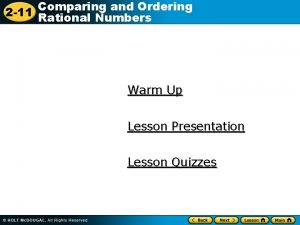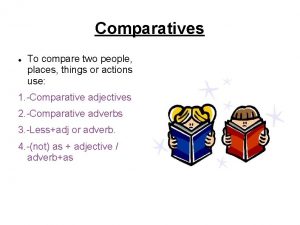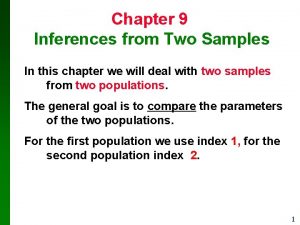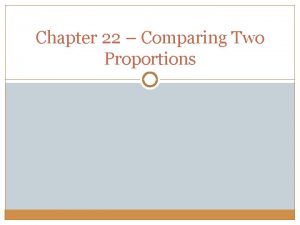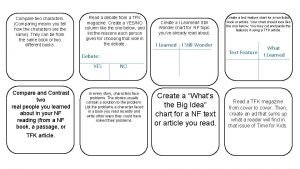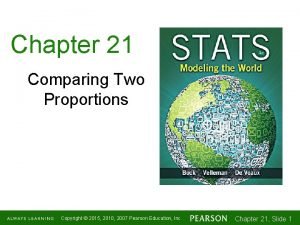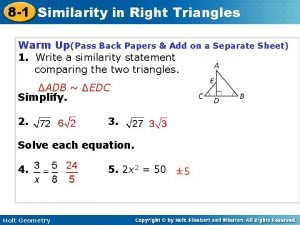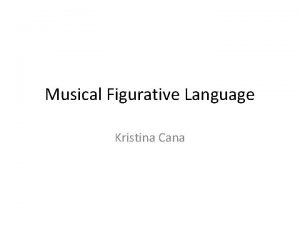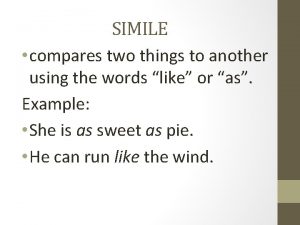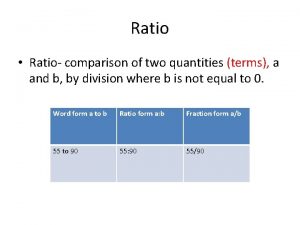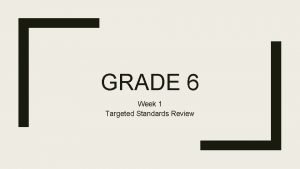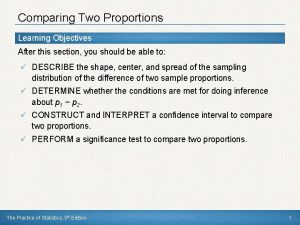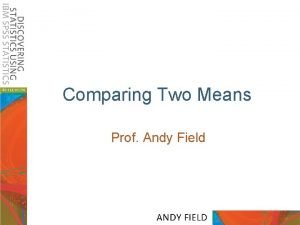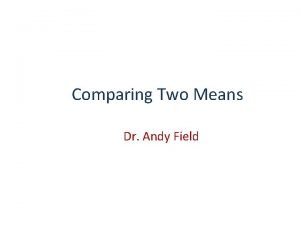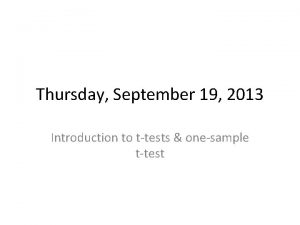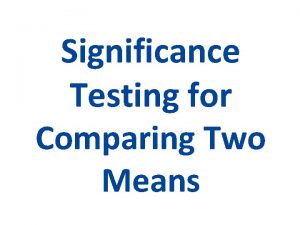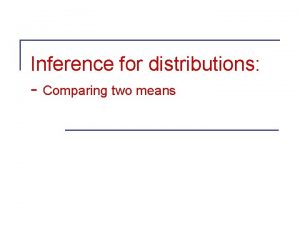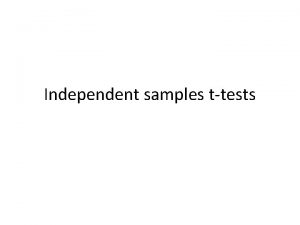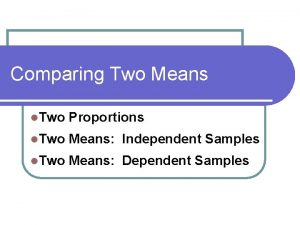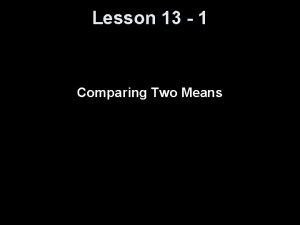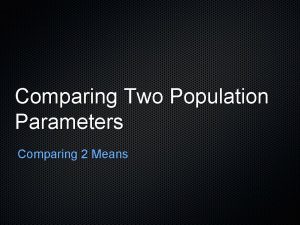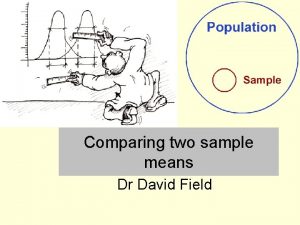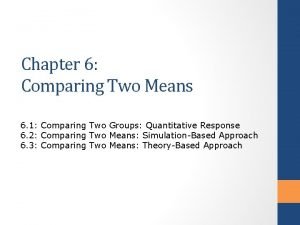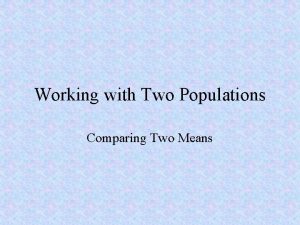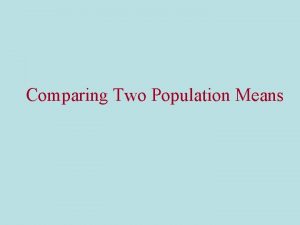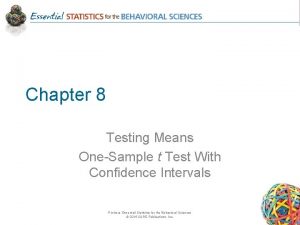Comparing Two Means Onesample Pairedsample ttests Lesson 13






















- Slides: 22

Comparing Two Means: One-sample & Paired-sample t-tests Lesson 13

Inferential Statistics Hypothesis testing l Drawing conclusions about differences between groups l Are differences likely due to chance? n Comparing means l t-test: 2 means l Analysis of variance: 2 or more means ~ n

Comparing 2 means: t-tests One-sample t-test l Is sample likely from particular population? n Paired-Sample t-test l 2 dependent (related) samples n Independent-samples t-test l 2 unrelated samples ~ n

The One-sample t-test Evaluating hypothesis about population l taking a single sample l Does it likely come from population? n Test statistics l z test if s known l t test if s unknown ~ n

t statistic

Example: One-sample t-test Survey: college students study 21 hr/wk l Do Coe students study 21 hrs/week? l Select sample (n = 16) n s unknown n Nondirectional hypothesis: l H 0 : m = 21; H 1 : m ¹ 21 l reject H 0 if increase or decrease n PASW/SPSS: Test value = 21 l Assumed from H 0 ~ n

PASW One Sample T Test n n Menu l Analyze l Compare Means l One-Sample T Test Dialog box l Test Variable(s) (DV) l Test Value (value of m testing against) l Options (to change confidence intervals) ~

PASW Output *1 -tailed probability: divide Sig. 2 -tailed by 2

Paired-Samples t-tests 2 samples are statistically related l Less affected by individual differences l reduces variance due to error n Repeated-measures l 2 measurements on same individual n Matched-subjects l Match pairs on some variable(s) l Split pairs into 2 groups ~ n

Difference Scores Find difference between each score l D = X 2 - X 1 l Requires n 1 scores equal n 2 scores n Calculate mean D n l n And standard deviation of D l ~

Repeated-measures 2 measurements of same individual n Pretest-posttest design l measure each individual twice l pretest treatment posttest l compare scores ~ n

Matched-subjects Match individuals on important characteristic l individuals that are related l IQ, GPA, married, etc n Assign to different treatment groups l each group receives different levels of independent variable ~ n

Assumptions: Related Samples n Population of difference scores is normal n Observations within each treatment independent l scores for each subject in a group is independent of other subjects scores ~

Related-samples Hypotheses Nondirectional l H 0: m D = 0 l H 1: m D 0 n Directional l H 0: m D > 0 l H 1: m D < 0 l Remember: it depends on the direction of the prediction ~ n

Sample Statistics n Mean difference n Mean for single sample

Standard Deviation: Related-samples Single sample

Estimated Standard Error n Calculate same as single sample l use standard deviation of difference scores

Test Statistic n Related-samples t test l Since m. D= 0

Example Is arachnophobia limited to real spiders or is a picture enough? n Participants l 12 spider phobic individuals n Manipulation (IV) l Each person exposed to a real spider & picture of same spider at two different times n Outcome (DV): Anxiety n

PASW Paired-Sample T Test n n n Data entry l 1 column each DV Menu l Analyze l Compare Means l Paired-Sample T Test Dialog box l Paired Variable(s) (DV) l Options (to change confidence intervals) ~

PASW Output

Reporting the Results n On average, participants experienced significantly greater anxiety to real spiders (M = 47. 00, SE = 3. 18) than to pictures of spiders (M = 40. 00, SE = 2. 68), t(11) = − 2. 47, p <. 05
 Chapter 24 comparing means
Chapter 24 comparing means Comparing means in excel
Comparing means in excel Resting pulse rates for a random sample of 26
Resting pulse rates for a random sample of 26 Lesson 8: comparing series and parallel rlc circuits
Lesson 8: comparing series and parallel rlc circuits V r and i in parallel circuits ch.8:1 answer key
V r and i in parallel circuits ch.8:1 answer key Lesson 3-2 adding rational numbers
Lesson 3-2 adding rational numbers How do you compare and order integers
How do you compare and order integers Lesson 3-3 comparing and ordering rational numbers
Lesson 3-3 comparing and ordering rational numbers Comparing two things not using like or as
Comparing two things not using like or as Comparing two things using like or as
Comparing two things using like or as Compare two people
Compare two people Comparing two population variances
Comparing two population variances Chapter 22 comparing two proportions
Chapter 22 comparing two proportions Chapter 10 comparing two populations or groups answer key
Chapter 10 comparing two populations or groups answer key A simile compares two things
A simile compares two things Comparing two characters
Comparing two characters Chapter 21 comparing two proportions
Chapter 21 comparing two proportions Uppass
Uppass Comparing two things without using like or as
Comparing two things without using like or as Comparing two things without using like or as
Comparing two things without using like or as Is a comparison of two quantities
Is a comparison of two quantities Chris and jenny are comparing two similar punch recipes
Chris and jenny are comparing two similar punch recipes Chapter 22 comparing two proportions
Chapter 22 comparing two proportions
